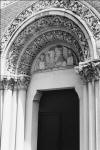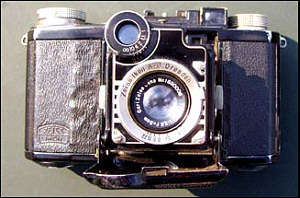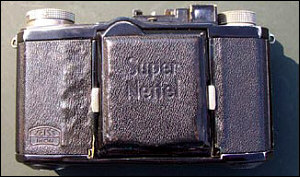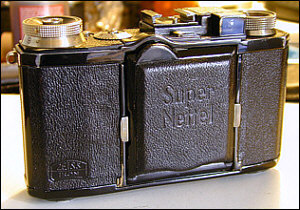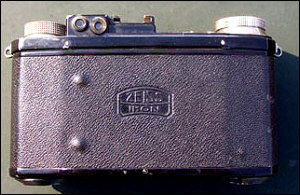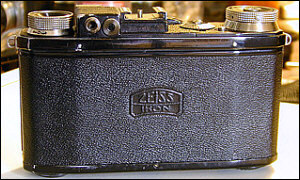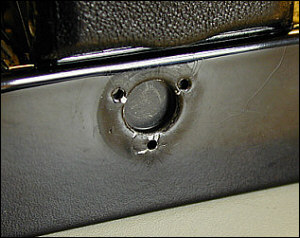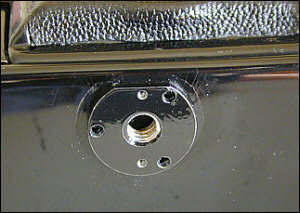Zeiss Ikon Super Nettel: Contax Lite?
This line of folding cameras was introduced in 1934 with production ending in 1938. One book that I have refers to it as the "poor man's Contax" at the time of its introduction into the market. My camera has an f/3.5 Triotar, although I really wanted to have one with the Tessar. Still, I couldn't pass it up. The Super Nettel uses the Contax shutter with speeds running from 1/5 to 1000 plus B -- a modern setup for that era -- perhaps one of the few folding 35mm rangefinder cameras to have a vertically traveling focal-plane shutter. There were three versions of the Super Nettel. This is the original Super Nettel. The Super Nettel II featured a chrome top deck and chrome lens door. My book makes mention of a Super Nettel III but provides no details.
The film advance and the shutter release is similar to the Contax II, right down to the push-and-turn shutter lock for long exposures. The frame counter is like the one that is used on the Contax I. The top deck of the camera includes an accessory shoe, although the shutter isn't flash synchronized. The accessory shoe is there to hold the Contameter that is part of a close-up kit, which included three Proxar lenses and matching eyepieces.
You focus the lens by rotating the small wheel on the upper corner of the lens panel. If your fingers are long enough, you can reach the wheel with your middle finger and you never have to remove your index finger from the shutter release. The attention to detail of the Super Nettel is impressive. As part of my restoration, I removed every piece of leather from the body. Zeiss Ikon even went to the trouble to cut a tiny piece of leather, roughly 1/4-inch square for a single area. The top deck is held on by roughly a dozen screws of various lengths and widths. The camera is very easy to use "out in the field." You won't set any speed records in shots per minute, but that's OK. This camera was marketed during a time when speed wasn't necessarily the most important thing to the amateur photographer.
As well, using a camera with two viewfinders requires some patience on the part of the photographer. Same goes for an all-manual camera in which you must meter a scene and then set apertures and shutter speeds accordingly. In my limited experience, I've found the Triotar to be quite a good lens for a triplet. Most triplets will be soft in the corners, especially when shot wide open. However, that's not what I've found with the Carl Zeiss Jena Triotar. And when stopped down, it's extremely sharp. Rewinding the film is another exercise in patience. As I mentioned, the viewfinder prevents the photographer from getting a firm grip on the rewind knob; it can only be turned in small increments. Loading the film is like loading most Zeiss Ikon cameras. You unlock the back using the two small "keys" on the camera base. The back then slides off. The camera accepts the standard Contax takeup spool, which can be used with regular 35mm film. You can also use two Zeiss Ikon film cassettes, which eliminate the need to rewind the film. You simply wind from one cassette to the other. The keys open and close the cassettes. Restoring the camera I think it took me about four hours to completely restore the Super Nettel. Unfortunately, someone had pried the tripod foot from the base of the camera. I was forced to improvise, using a Retina tripod socket until I can locate a suitable replacement. Unfortunately, the correct replacement would be from an early model Contax I, so I think I'll have to give this some more thought. Below are before and after photos. The before photos are from eBay.
In the photos above, what looks like bubbles under the leather in the after photos is really because the surface under the leather isn't flat. There is a small L-shaped cutout that exposes part of the shutter mechanism. It's covered by a thin, square brass leaf. |
||||||||||||
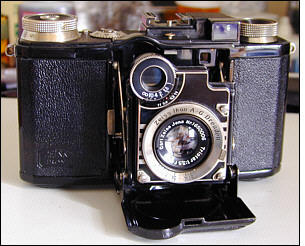 The
Zeiss Ikon Super Nettel is best described as a mix of old and new,
borrowing from the Contax I and Contax II, as well as the old
Nettel-Contessa press and folding cameras.
The
Zeiss Ikon Super Nettel is best described as a mix of old and new,
borrowing from the Contax I and Contax II, as well as the old
Nettel-Contessa press and folding cameras.
 The camera features a coupled rangefinder that uses two rotating wedge
prisms like the Super Ikonta. Because of the use of prisms within the
rangefinder assembly, it doesn't go out of alignment easily like a
system that is based on mirrors. There are two viewing windows: The one to
the right is
used for focusing, while the one on the left is used to compose your photo.
The rewind knob is uncomfortably close to the rangefinder/viewfinder
housing -- rewinding film takes even longer than most knob-rewind
cameras.
The camera features a coupled rangefinder that uses two rotating wedge
prisms like the Super Ikonta. Because of the use of prisms within the
rangefinder assembly, it doesn't go out of alignment easily like a
system that is based on mirrors. There are two viewing windows: The one to
the right is
used for focusing, while the one on the left is used to compose your photo.
The rewind knob is uncomfortably close to the rangefinder/viewfinder
housing -- rewinding film takes even longer than most knob-rewind
cameras. 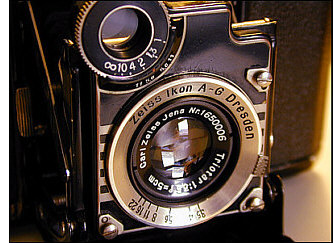 You open the camera by pressing the small brass button that sits just
above the lens door. The handsome art deco lens panel will partially
extend. Grab the lens panel on either side at the serrated edges and pull
forward until it locks into place. Contessa-Nettel aficionados might note
that the Super Nettel uses scissor struts -- reminiscent of the old
Contessa-Nettel folders and press cameras.
You open the camera by pressing the small brass button that sits just
above the lens door. The handsome art deco lens panel will partially
extend. Grab the lens panel on either side at the serrated edges and pull
forward until it locks into place. Contessa-Nettel aficionados might note
that the Super Nettel uses scissor struts -- reminiscent of the old
Contessa-Nettel folders and press cameras.